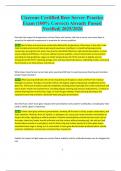Cicerone Certified Beer Server Practice
Exam (100% Correct) Already Passed
|Verified| 2025/2026
Describe the impact of temperature on beer flavor and aroma, and how a server can ensure beer is
served at the optimal temperature to maximize its sensory qualities.
Beer’s flavor and aroma are profoundly affected by temperature. When beer is too cold, it can
mask complex aromas and reduce perceived sweetness, resulting in a muted tasting experience.
Conversely, serving beer too warm may lead to intensified bitterness, high alcohol perception, or even
reveal undesired off-flavors. To ensure optimal sensory qualities, servers should store and serve beer
according to style guidelines: lagers at colder temperatures (35-45°F) and ales at slightly warmer
temperatures (45-55°F). Checking storage units and pouring temperatures, calibrating coolers, and using
thermometers can help achieve consistency.
What steps should a beer server take when pouring draft beer to avoid excessive foaming and maintain
proper head retention?
When pouring draft beer, the server should ensure the glass is clean and free from residual
detergent or grease. The glass should be held at a 45-degree angle and gradually straightened as the
glass fills. The faucet should be opened completely, avoiding partial openings that create turbulence and
excess foam. Proper line maintenance, including regular cleaning and pressure adjustments, is critical to
prevent foaming due to dirty lines, clogs, or incorrect gas settings. Proper pouring technique and
equipment care help maintain a balanced head and good presentation.
Describe how a beer clean glass impacts beer presentation and customer satisfaction, including key tests
used to verify a glass's cleanliness.
A beer clean glass enhances presentation, showing off the beer’s clarity, proper carbonation, and
foam retention. Residues from oil, lipstick, or detergent can cause poor head retention and bubbles to
cling to the sides, signaling an inferior product. Properly cleaned glasses should pass key tests such as
the water sheet test (water should uniformly coat the surface without beading up), the salt test (salt
should adhere evenly to a wet glass), and the foam cling test (a beer poured in a clean glass leaves
consistent foam rings or lacing as it is consumed). A clean glass demonstrates professionalism, boosts
customer satisfaction, and ensures consistent beer enjoyment.
Explain the impact of light exposure on beer flavor stability and the methods brewers use to mitigate this
risk.
1
, Exposure to light, especially ultraviolet and blue light, can lead to “skunky” flavors in beer due to
photochemical reactions with hop compounds, producing 3-methyl-2-butene-1-thiol (MBT). This
reaction, known as lightstruck, can happen rapidly in clear or green bottles. To mitigate this, brewers
often use brown bottles, cans, or kegs that block light. Additionally, some employ specially modified hop
extracts that do not produce MBT when exposed to light. Educating staff on proper storage and
minimizing beer's exposure to light is critical for maintaining flavor stability.
Describe the primary characteristics of an American Pale Ale (APA) and its distinguishing features from
an IPA.
American Pale Ales (APAs) showcase a balance between malt sweetness and hop bitterness,
typically using American hop varieties that provide citrus, pine, floral, or fruity notes. APAs have
moderate alcohol content (generally 4.5-6.2% ABV) and a medium body, often with a caramel-like malt
presence. Compared to India Pale Ales (IPAs), APAs are less intense in terms of bitterness, aroma, and
alcohol strength. While IPAs emphasize hop-forward flavors and aromas, APAs aim for a harmonious
balance, offering a more accessible, sessionable beer.
Outline the steps involved in properly cleaning and maintaining draft lines, including frequency and key
equipment used.
Proper draft line cleaning involves disconnecting the beer line from the keg and flushing it with
water, followed by circulating an alkaline cleaning solution for at least 15 minutes using a recirculating
pump or a pressure pot. This removes yeast, biofilm, and protein buildup. After cleaning, the line is
thoroughly rinsed with water until no cleaning solution remains. Acid cleaning is recommended every
three months to remove mineral deposits. Key equipment includes couplers, faucets, and gaskets, all of
which must be disassembled, cleaned, and checked for wear. Cleaning is essential every two weeks to
maintain beer quality and avoid flavor contamination.
Explain how carbonation levels affect beer's mouthfeel and drinkability, including how servers can assess
and address issues with carbonation.
Carbonation affects beer's mouthfeel by providing effervescence that can make the beer feel
crisp and refreshing or heavy and creamy, depending on the level. Highly carbonated beers can be sharp
and prickly, enhancing certain flavors and reducing perceived sweetness, while low-carbonated beers
offer a smoother, rounder mouthfeel. Servers can assess carbonation issues by observing how the beer
pours, whether it appears flat or over-foamed, and by sampling it. Issues may arise from incorrect gas
pressure or dirty lines; adjusting pressure settings and maintaining clean lines is crucial for correcting
these concerns.
Discuss the origin and unique brewing characteristics of the Belgian Dubbel, including typical flavor
profiles and pairing suggestions.
2




